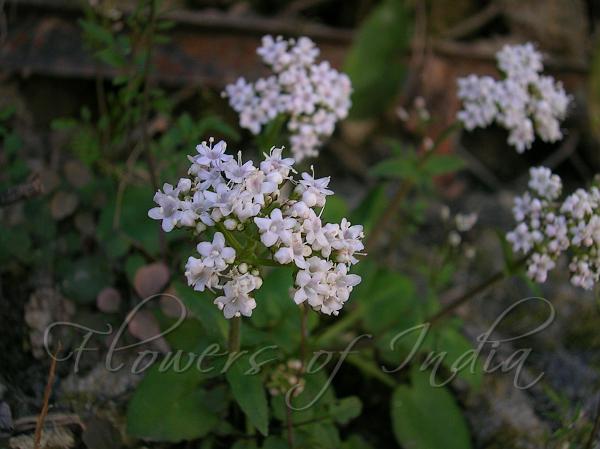|
| Jatamansi |
|

|

| File size | 677865 |
| Original date | 2/28/06 11:35 AM |
| Resolution | 2048 x 1536 |
| Flash | Flash did not fire, auto |
| Focal length | 8.0mm |
| Exposure time | 1/143s |
| Aperture | 3.2 |
| Focus Distance | |
| Metering Mode | Partial |
| Camera make | NIKON |
| Camera model | E3700 |
| Sensor type |
|
|
|
|
Photo: |
Botanical name: Valeriana jatamansi Family: Caprifoliaceae (Honeysuckle family)
Synonyms: Valeriana wallichii, Valeriana harmsii, Valeriana mairei
Synonyms: Valeriana wallichii, Valeriana harmsii, Valeriana mairei
Jatamansi is a forest perennila herb, 0.5-2 ft
tall, velvet-hairy to hairy. Rhizome are elongate, with fibrous roots.
Stems are 3-6 in number. Leaves at the base are heart-shaped or ovate,
2-10 cm x 1.5-8 cm, toothed or wavy-toothed. Stem leaves are stalkless,
smaller, uppermost often cut. Snow-white flowers are borne in
flat-topped clusters on top of the stems. Upper bracts are
linear-lanceshaped, about 3 mm long. Stigma is 3-fid. Seed-pods are
velvety, shorter than the upper bracts. Jatamansi is found throughout
the Himalayas, from Afghanistan to SW China, at altitudes of 1500-3600
m. Flowering: March-May.
Medicinal uses: Jatamansi is well-know in traditional Indian
medicine. It is supposedly useful in diseases of eye, blood and livers,
is used as a remedy for hysteria, hypochondriasis, nervous unrest and
emotional stress. Also useful in clearing voice and acts as stimulant
in advance stage of fever and nervous disorder. The paste of roots
mashed in water is applied on forehead to alleviate the pain.
Externally, the paste of its roots is applied in wounds for better
healing.
Jatamansi is well-know in traditional Indian
medicine. It is supposedly useful in diseases of eye, blood and livers,
is used as a remedy for hysteria, hypochondriasis, nervous unrest and
emotional stress. Also useful in clearing voice and acts as stimulant
in advance stage of fever and nervous disorder. The paste of roots
mashed in water is applied on forehead to alleviate the pain.
Externally, the paste of its roots is applied in wounds for better
healing.
Medicinal uses:
 Jatamansi is well-know in traditional Indian
medicine. It is supposedly useful in diseases of eye, blood and livers,
is used as a remedy for hysteria, hypochondriasis, nervous unrest and
emotional stress. Also useful in clearing voice and acts as stimulant
in advance stage of fever and nervous disorder. The paste of roots
mashed in water is applied on forehead to alleviate the pain.
Externally, the paste of its roots is applied in wounds for better
healing.
Jatamansi is well-know in traditional Indian
medicine. It is supposedly useful in diseases of eye, blood and livers,
is used as a remedy for hysteria, hypochondriasis, nervous unrest and
emotional stress. Also useful in clearing voice and acts as stimulant
in advance stage of fever and nervous disorder. The paste of roots
mashed in water is applied on forehead to alleviate the pain.
Externally, the paste of its roots is applied in wounds for better
healing. | Identification credit: Monideepa Mitra, Amit Kumar | Photographed in Mussoorie, Uttarakhand. |
• Is this flower misidentified? If yes,